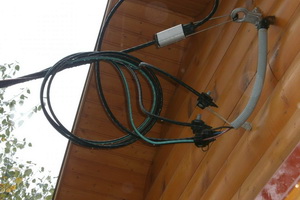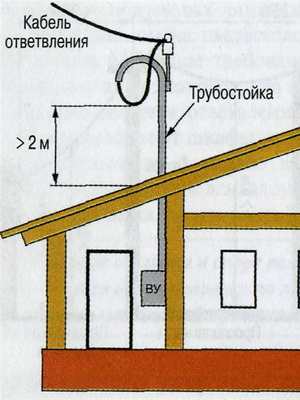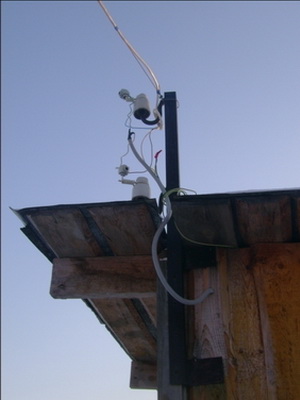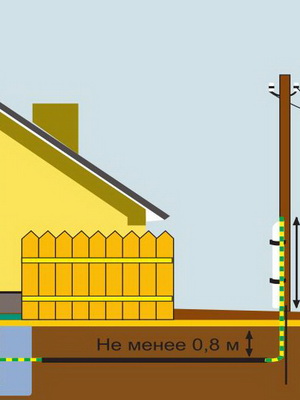Underground input of electricity to a private house. Proper input of electricity to a private house and to the site. Underground electricity input to the house underground
Theoretically, an underground spur appears to be a more stable and safe type of spur that is not subject to wind loads, icing breaks, touching long objects, or the passage of an oversized vehicle. But all this is true only if the entire underground branch passes through your site. Imagine that some part of your underground branch runs along the street or, God forbid, along a neighboring site, and your neighbor decided to connect to the water supply and hired guest workers to dig a ditch just through the place where your underground branch line passes ...
Who can demand that all community facilities be underground?
If the local electrical authority requires that the electrical installation or wiring be upgraded as part of the conversion. Whether or not an electrician is doing the work of digging and filling the trench needed to bring underground structures from slavery to construction is the length of trench that is needed to accommodate the conversion. It is possible that the outer head extends through the roof of the building, in which case you may also need the cost of repairing the roof painting and aesthetics. The existing airspace of the area may be converted if the community so desires.
The beginning and end of the underground branch from the overhead line must be laid in a protective metal pipe that emerges from the ground to the support and to the steppe of the building to a height of at least 1.8 m. Part of the underground branch between the initial and final pipe is entirely in the ground and may not be protected by the pipe. Ideally, if on a support or on a wall of a building, the pipe will reach the VU cabinet. In the ground, the initial and final pipes should reach a line laying depth of 0.6 ... 0.8 m and have a horizontal section, the length of which is not negotiated . That is, both pipes must have L-shape. It is very useful to protect with pipes and a section of the underground line between the initial and final pipe. Pipes should not be butted. Between them it is better to leave a gap of several centimeters or make it so that the pipe sections fit one into the other.
Any person who is willing and able to pay the conversion fee and guarantees the necessary access to place the premises on private property may submit a written request. This includes local governments, large or small communities, builders and developers in a particular area, such as a subdivision.
In general, yes, due to the following conditions for such a conversion. Passage Access: All access passes must be purchased before the underground electrical distribution system is installed. In the case of an underground conversion, this also means making a decision about what property will take over the new pedestal transformers and switch cabinets that are installed on the ground as part of the underground network. Otherwise, any subsequent disagreement may delay the conversion project and increase costs.
Underground lines are never made of separate conductors, this requires a cable. After laying the underground branch, the trench is covered with sand, and then with seeded pounds without solid inclusions and foreign objects. Of decisive importance for the underground branch cable is the strength of the outer insulation. Copper is recommended as the conductor material for the cable. There are no restrictions on the minimum size of the cross section of the conductors, based on strength considerations, like overhead cables, for underground cables. The most commonly used sections are 6 and 10 m / t. IN this case the margin does not hurt, therefore it is recommended to use a copper cable with a core cross section of at least 10 mm 2. The industry produces a special armored cable of the VBbShv type (wrapped with a steel tape with a PVC insulation sublayer), which comes with three, four and five conductive cores. Steel protective pipes are selected with such a diameter that the cable occupies no more than 50% of their internal section.
We are working on the preparation of appropriate agreements that allow this option for our customers. We will have more information in the coming months. The two key factors involved in costing are labor and materials. While these figures include considerable variability, there is an established process in which a rough budget is created to determine the amount of cost that the community may consider.
Owners who benefit from the conversion must be identified, while special settlement must be collected directly by the local government through settlement taxation or annual property taxes. Another Florida law, 01, allows counties to create subdivisions to provide municipal services and municipal tax units in certain areas. These government entities may charge service fees, special fees or taxes in these units to fund the costs of underground conversion.
We are waiting for you in the office for a free consultation on engineering networks!
Foreword
Proper input of electricity into the house guarantees an uninterrupted supply of energy for the operation of all household appliances.
Content
 Proper input of electricity into the house guarantees an uninterrupted supply of energy for the operation of all household appliances. The introduction of electricity to the site begins with the approval of the project and the receipt of technical specifications from the energy supply organization. Then the introduction of electricity into a private house provides for the organization of all components of the internal network. Installed meters and distribution devices. Direct input to the house of electricity is carried out by specialized contractors. But in terms of primary preparation, the input of electricity can be carried out partially on its own.
Proper input of electricity into the house guarantees an uninterrupted supply of energy for the operation of all household appliances. The introduction of electricity to the site begins with the approval of the project and the receipt of technical specifications from the energy supply organization. Then the introduction of electricity into a private house provides for the organization of all components of the internal network. Installed meters and distribution devices. Direct input to the house of electricity is carried out by specialized contractors. But in terms of primary preparation, the input of electricity can be carried out partially on its own.
Why install some equipment in an underground system above ground?
Directional perforation in conversions is generally preferred to minimize impact on other services, which are typically buried higher than electrical cable and cable. Guided drilling, although it can save on site restoration work, is a more expensive job. Those who pay usually prefer open excavation, as this is the most economical method. Additionally, one advantage of digging trenches is that other underground utilities can use the same trench, which reduces the overall cost of burying multiple sites.
Scheme of entering electricity into the house
The scheme for introducing electricity into a house is strikingly different from the electrification of a home in apartment building. Living in an apartment, you may not know anything and not even guess about the existence of all kinds of input devices, gas grounding buses, electrical panels and other equipment, and entrust all issues related to electricity to the Housing Office, Homeowners' association, etc. Being engaged, you will have to decide everything yourself, including delving into the many subtleties of the operation of electrical equipment. It is also important to consider that the apartment is a relatively small room with almost the same microclimate.
However, this requires considerable coordination. The disadvantage of open trenches is the amount of surface remediation required, such as gardens and sidewalks. Given that the location of other government services is not always known, especially in older communities, there is still a risk associated with trenching and drilling that could affect others. underground structures such as water and sewer lines, gas pipelines or drainage lines.
New construction requires front aisle access and is also often required for conversions between air and metro as they provide faster access to the facility. In the event of a failure, facilities at the rear of the property may not be accessible due to closed gates or dogs on the property. The inability to access transformers and other equipment may delay the restoration of the entire district. The 10 foot access requirement will continue to apply.
A private house is literally given over to all the elements - heat, frost, wind and precipitation, which, in turn, has a lot to do with a stable supply of electricity. In addition, on suburban area Electricity is connected not only to residential buildings, but also to various outbuildings.
As a rule, electrical work begins simultaneously with construction. Before building a house, you should think carefully about how to bring electricity to the site.
Why does access to passageways associated with underground facilities need to be at least 10 feet wide?
If access is difficult, why not put underground facilities in public law passage, and not on private property. The reason is that if not, every road widening or improvement project can jeopardize the company's ability to provide safe, reliable and uninterrupted power. In these special cases, only cables and conduits in public road rights are allowed. However, our experience shows that local authorities are unwilling to grant such access rights or equivalent access.
Two electrical inputs
There are two inputs of electricity to the house: air and underground. The most common is the laying of an overhead line from a power transmission line (TL) to the house.
First, you should determine the distance between the support and the wall of the house through which the input will be made.
All work on connecting a private house to a power line can only be performed by a specialist of the organization that owns this line.
As for other facilities and equipment required for underground service, such as primary junction boxes, transformers and distribution cabinets, these subsystem components will still need private property access so that we can regularly access and maintain the equipment and provide reliable service.
Is it possible that only the wires in front of my house are buried if none of my loved ones wants to participate. Depending on the location, it is possible that several blocks need to be converted to complete this "ring". Which makes it much more costly to do conversions on new designs, especially since the client pays for most of the peripheral work. This work involves building an entirely new system while working on an existing service, then tearing down the previous service after it is up and running.
Pipe stand for input of electricity
 If it is more than 20 m, then you will have to put an additional support in the middle - between the house and the support pole, since the cable can break under its own weight or under the influence of wind and precipitation. A cable is pulled from the support to the wall of the house to support the cable and prevent it from sagging. This structure is called a pipe rack for introducing electricity into the house by air.
If it is more than 20 m, then you will have to put an additional support in the middle - between the house and the support pole, since the cable can break under its own weight or under the influence of wind and precipitation. A cable is pulled from the support to the wall of the house to support the cable and prevent it from sagging. This structure is called a pipe rack for introducing electricity into the house by air.
The higher costs also reflect the fact that crossings in older quarters, regardless of the type of excavation we use, carry a lot of problems with working in and around; In addition, impact on other public services such as telephone, cable, sewerage, gas networks, water pipes etc. Finally, all new underground components must be purchased and installed, including conduits, cable, pedestal transformers and switch cabinets.
In addition, the separation of main lines is often required, which is even more costly than the conversion of individual service lines and the surrounding area. Typically, demolition accounts for about 15 percent of the cost, installation of underground components for about 65 percent, and excavation for about 20 percent.
The conductor is attached to the cable with clamps. If the cable runs over the carriageway, then it must be at a height of at least 6 m from the ground, if above pedestrian roads - at a height of at least 3.5 m. It is not allowed to pass the cable through thickets of bushes and tree crowns. The point of attachment of the line to the wall is located at a height of at least 2.75 m.
What are some of the implications of converting an existing air system into a new underground. Converting an antenna system to an underground system basically means abandoning the existing grid system. The logistics of converting an existing grid system into a designated area can be significantly more costly and harmful to private property and its environment than, for example, building a new system. For example, utilities often share positions located above ground, so if the goal is to relocate underground utilities, it is necessary to consider not only electricity, but also telephone, cable television and the Internet.
The input of energy into the house must be organized as carefully as possible, the reliability of the power supply of the house and its safety depend on this. The cable can be laid in several ways.
Air power input
 The air input of electricity is carried out as follows: the cable is attached to special insulators, which are attached to the wall with a hook (if the wall is wooden) or special fasteners (if the wall is made of stone). Then the cable is passed through the wall through a metal pipe; for its free passage, it is advisable to choose a larger pipe diameter.
The air input of electricity is carried out as follows: the cable is attached to special insulators, which are attached to the wall with a hook (if the wall is wooden) or special fasteners (if the wall is made of stone). Then the cable is passed through the wall through a metal pipe; for its free passage, it is advisable to choose a larger pipe diameter.
This introduces additional considerations such as different space requirements, drilling needs, and excavation of trenches and junction boxes at ground level to provide each type of service. Streets, sidewalks, fences, gardens, irrigation systems, and patios may need to be broken down or are accidentally damaged or not clearly defined. Entrances to and exits from homes and businesses can be affected for a long time. Since permits must be obtained to change equipment associated with the equipment, conversions in older homes and areas may mean city or county requirements for homeowners and businesses to improve internal wiring to match the code in force.
To prevent rain from entering the pipe through which the cable enters the house, its end can be slightly pushed out of the wall and bent down.
If a cable is used, you can limit yourself to one metal pipe. When using a special SIP wire, a plastic one is inserted inside the metal pipe, since this conductor does not have an outer sheath, but only core insulation. To close the opening of both pipes, special sleeves are put on them. Gap between cable and inner surface pipes are filled with mineral wool - it serves as an additional insulation and insulator.
What is pass slavery?
This may require the cost of an authorized electrician and possibly extensive internal remodeling for wiring. It is a restriction tied to property, giving freedom of passage to others. This passage may be on the surface, as in the basement. The administration can, for example, impose the passage of a power line on your land, or your neighbor has the right to cross your garden.
These restrictions impose rights and obligations. And if you can't do anything that gets in the way of that bondage, the beneficiary can't do anything that makes your situation worse. The state or municipality sometimes has to put its facilities on private land. For electricity, the administration has the right to impose on individuals hanging cables on the facade, or to bury the lines in underground pipelines. He can also install pylons in properties, as well as prune or trim trees that threaten his equipment.
Inside the house, the cable is inserted into the house shield and connected to the control and protection circuit breakers.
Air cable laying
In order to carry out the air laying of the cable, a special metal pipe-riser is used, which serves both as a channel for the cable and as a support for fastening the insulators. Mounting insulators to such a rack is much easier than to the wall of the house. You can use fasteners for metal - self-tapping screws or bolt clamps. The pipe rack for the input of electricity is connected to the ground wire. The cable itself must be located at least 2 m from the roof surface. For laying an overhead line, almost any type of cable or wire is used, the main thing is that its characteristics satisfy the conditions of outdoor wiring.
Similarly, the administration can bury gas pipes on private land, provided that they are not built, but once in place it is still possible for a person to close his land and build his house under of course not to jeopardize the installation. For the licensee, the concessionaire has the opportunity to install recharging of the aqueduct.
With regard to the presence of a hydrocarbon pipeline buried in the garden, it prohibits the owner from building or planting in a strip of land 5 meters around the pipe. In the mountains there is also an easement for ski lifts. It allows towers to be erected on private property at least 20 meters from houses or dipped, generally these easements are established by prefectural order after a public inquiry. user depending on the harm caused. In the absence of an agreement, compensation is determined by the expropriation judge.
The choice of SIP wire for electrical wiring
Until 1991, AC wires without insulation were used for laying the overhead line. Now the choice of SIP wire has been replenished with another sample designed specifically for overhead lines. Its insulation is designed for large temperature differences and resists sunlight well. In addition, such a cable is not stretchable, it can be laid without a supporting cable. The choice of wire for electrical wiring is quite simple: there are two types of SIP - two-core and four-core. The most common varieties are SIP 4 x 16/25 and SIP 2 x 16/25. The numbers indicate the number of cores and their cross section. There are many additional accessories for this wire. They are used to connect the wire to the mount, they are very convenient and do not require much effort during installation.
The entire property must have direct access to the highway. When this is not the case, he can exercise the right of way with a neighbor. This occurs when a piece of land is isolated in the middle of other parcels, or because access to the street is not possible, for example due to a steep slope. It also happens that the passage exists, but it is too narrow to enter the car.
The passage should be as short as possible to reach the public road, provided that this should not cause unbearable harm to the neighbor. It will preferably run along the fence rather than in the middle of the garden. If landlocked is the result of large property sharing, the passage must be on one of the lots and not on land owned.
Underground electricity input to the house underground
 underground input home electricity is considered safer because the cable is in the ground and is not affected by weather and climatic conditions. However, the input of electricity underground is the most laborious: to lay the cable, it is necessary to dig a trench at least 0.7 m deep.
underground input home electricity is considered safer because the cable is in the ground and is not affected by weather and climatic conditions. However, the input of electricity underground is the most laborious: to lay the cable, it is necessary to dig a trench at least 0.7 m deep.
To begin with, the L-shaped bent pipes that protect the cable are attached to the support and the wall of the house - for this, one end of the pipe rises to a height of at least 1.8 m. The other end goes into the ground to the depth of the cable (usually this distance is 80 cm). It is best when the cable is protected by a pipe along the entire installation path. However, if there is no pipe of sufficient size, you can limit yourself to protecting the cable entry into the ground and in the open air. This is the easiest and cheapest way to run a cable underground.
Selection of the section of high-voltage wires according to the load
The selection of the wire cross-section according to the load is preliminarily made, taking into account the requirements of safety engineering. For laying in the ground without protection, the armored VBBSHv is best suited. If you decide to use VVG, AVVG or their modifications, it is better to protect the cable all the way with steel or plastic pipes. Select the diameters of the pipes so that they fit into each other, the border of the joints can be wrapped with a cloth and impregnated with resin or bitumen. Then you do not have to weld the pipes together, which is not only long, but also expensive.
The choice of high-voltage wires should be carried out taking into account the fact that the cable can be introduced into the building without lifting it to the wall, but hidden in it above the foundation. In this case, a hole is drilled in the wall slightly below ground level, where asbestos-cement pipes are embedded, through which the cable enters the house.
If there are several conductors, then there should also be several such pipes. The depth of the trench depends on the power of the supplied energy. If it does not exceed 20 kW, you can limit yourself to a depth of 70 cm, at 35 - 45 kW the depth should be at least 1 m. A depth of 1 m is also required if the cable passes through the road. When laying cables in plastic pipes enough depth of 50 cm.



